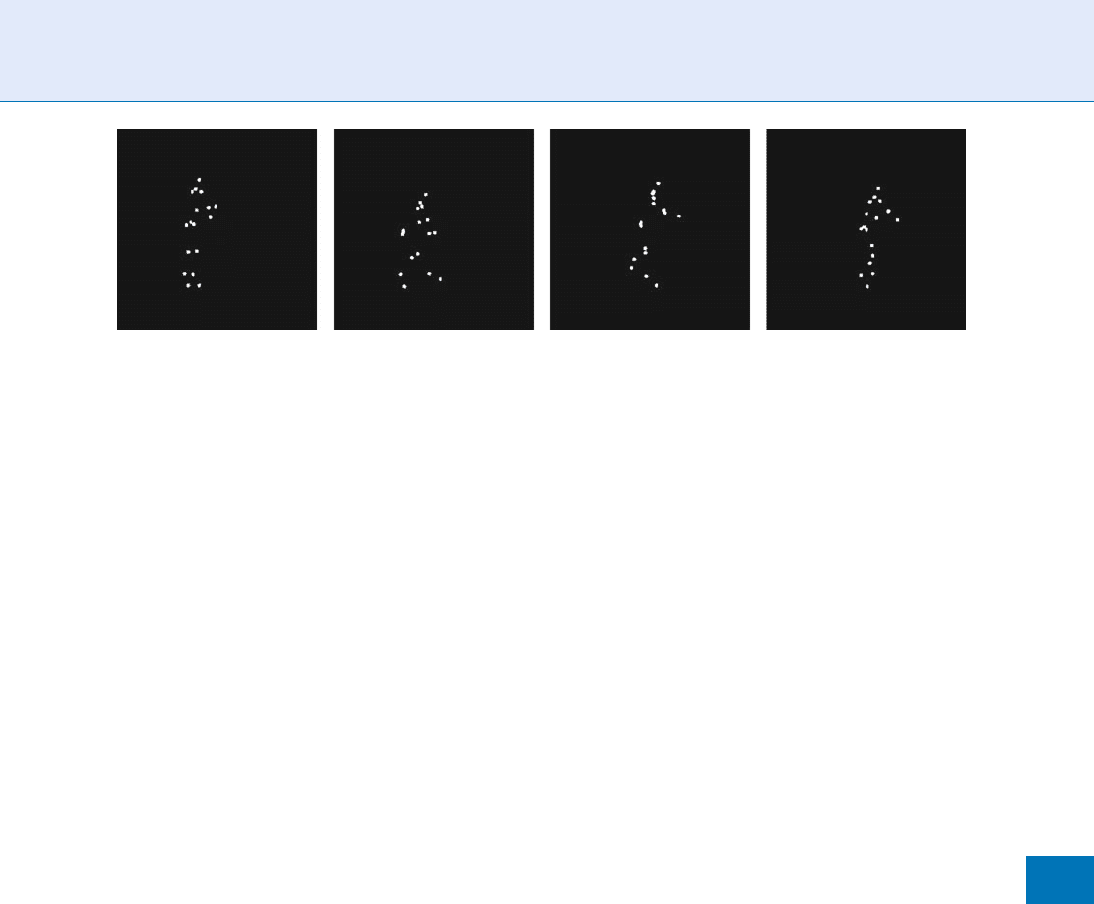Li S.Z., Jain A.K. (eds.) Encyclopedia of Biometrics
Подождите немного. Документ загружается.


Protocol
Protocol is the preset procedure by which each tem-
plate in the database is compared to some specific
feature during the performance evaluation of the fin-
gerprint-matching approach, and the rule to treat the
failed matching.
▶ Fingerprint Matching, Automatic
Pseudo-Random Number Generator
An algorithm to generate a sequence of numbers that
approximate the properties of random numbers. The
sequence is not truly random since it is completely
determined by a few parameters and initial values.
Pseudo-random numbers are useful for cryptography
and simulation.
▶ SFinGe
Psychology of Gait and Action
Recognition
FRA NK E. POLLICK
Department of Psychology, University of Glasgow,
Glasgow, UK
Synonyms
Action categorization; Action understanding; Biologi-
cal motion perception
Definition
The psychology of gait and action recognition strives
to understand the processes that underlie how people
detect, recognize and understand the movements of
others. Since gait is a fundamental human activity,
it has formed an impor tant visual signal for psycholo-
gists to examine. Experiments have shown that sparse
representations of gait support the recognition of iden-
tity, gender, and emotion by obser vers even when
viewing conditions are degrade d. The study of gait
and action recognition focuses on several questions,
including: what visual properties uniquely specify
human movement; how to quantify human perfor-
mance in action recognition; and the neural mechan -
isms that form the basis of decoding human
movement.
Introduction
The modern study of the psychology of human move-
ment, in particular the perception of gait, star ts with
the work of the Swedish Psychologist Gunnar Johans-
son in the 1970s [1]. The work of Johansson and his
contemporaries focused on how humans use motion
to infer the structure of objects moving in the world.
To demonstrate this capability, he attached lig hts to the
joints (elbow, shoulder, ankle, etc.) of an actor and
filmed the actor moving about in a darkened room.
In any indiv idual frame of the movie, the points did
not convey a strong impression of structure. However,
when the movie was played, a vivid impression of the
actor moving through space was obtained (Fig. 1).
These displays of human activity are called
▶ point-
light displays and the general field of studying how the
individual point motions spontaneously organize into
the percept of a moving body is known as
▶ biological
motion perception [2].
There are several reasons why point-light displays
form a key contribution to the psychology of under-
standing human actions. The first is that point-light
displays represent an action as just the 2D locations of
a set of joint locations on the body and thereby remove
a multitude of other visual information that can be
conveyed by things like hairstyle, clothes, facial expres-
sion, and other factors; thus the contribution of mo-
tion itself can be effectively isolated. A second reason
is that the relevance of motion is highlighted, since
for these displays any particular static frame typically
does not elicit a strong impression of a body. A third
reason is that the motion properties of a small set of
points can be easily quantified, allowing for biological
motion displays to be compared in exp eriments
against other motion patterns with identical motion
1100
P
Protocol

statistics. Finally, point-light displays of biological mo-
tion provide a compelling demonstration of the use of
motion to perceptually organize a display, the precise
mechanisms of which are still unclear.
Oneissuewiththeuseofpoint-lightdisplaysis
how to evalu ate the role of form perception. It could
be assumed that the mechanisms beh ind the percep-
tual organization of the p oint-li ght displays pro-
vide
▶ structure-from-motion information regarding
form [3]. However, this form information is not nec-
essarily equivalent to what might be available from
that presented directly from an image or even some
other reduced form such as a stick figure o r a silhou-
ette. The distinction between form and motion is
important from the psychological perspe ctive since
data from neuroscience suppor t the id ea that the
human visual system is segregated into largely distinct
pathways that specialize i n processing form and mo-
tion information.
The study of point-light displays has been critical
in developing the understanding of how motion can
be used to convey the presence of an actor from
minimal information, and to a degree psychological
research has focused in this domain. However, o ne
other question which has drawn attention is just what
person properties can be derived from the p oint-light
displays. Namely, can actor qualities such a s identity,
gender, emotion, attractiveness, and intent be i den-
tified from suc h displays? Experimental results gen-
erally indicate that human observers can identify
such qualities at better than chance, though what
cues they use and how to evaluate t heir performance
on an absolute scale are presently areas of active
researc h.
Psychological Studies into Perceiving
Biological Motion and Recognizing
Person Properties
In this section empirical investigations into biological
motion perception and action recognition is reviewed.
The majority of research into biological motion percep-
tionhasinvolvedpoint-lightdisplaysofgait.Researchinto
action recognition has typically also used point-light dis-
plays, though sometimes limited the visual display to
those points that change substantially for the different
actions.Anothermethodological differenc ebetween stud-
ies of biologicalmotion perception and actionrecognition
has been that research into biological motion perception
has typically relied upon psychophysical analyses of the
ability of observers, under normal and degraded viewing
conditions, to detect the presence of a walker or to dis-
criminate the walking direction [2]. In contrast, research
into action recognition has used a variety of experi-
mental techniques aimed at uncovering the underlying
features used by observers to recognize the action being
performed as well as properties of the actor.
Numerous e xp eriments have shown that the abi l-
ity of the perceptual system to detect the biological
motion of a walker is surprisingly resistant to distor-
tions of the walker or the embedding of the walker
in v isual noise. For instance, limiting the lifetime of
the points on the walker or displacing them to points
on the skeleton, as opp osed to joint locations, barely
diminishes the ability of an obser ver to detect a point
light walker. Furthermore, masking the motion of
the points using a background of randomly moving
noise dots still does not greatly reduce the impression
of a human walker unless the masking noise is used in
Psychology of Gait and Action Recognition. Figure 1 Examples of frames taken from an image sequence of a
point-light display of a ballet dancer. Each individual frame is seen predominately as just a collection of points, although
a static human form is possibly visible in some frames. However, a vivid impression of the action is appreciated nearly
instantaneously when all the frames of the sequence are presented consecutively in a motion sequence.
Psychology of Gait and Action Recognition
P
1101
P

combination with disruptions to the synchronization
between points on the walker [4]. This disruption
to synchronization, by introducing time delays and
advances among the points of the walker, renders
local motion cues ineffective for detecting biological
motion or discriminating the direction of motion,
forcing the perceiver to rely on global or configural
cues [5]. One effective way to mask the motion of a
walker is to take the walker points themselves as the
source of points to use as background noise. However,
even when this is done and the masking dots contain
local motion signals identical to those of the walker,
large numbers are required to diminish the impression
of a human walker [6].
The apparent fine tuning of the perceptual system
to point-light displays of walking has raised the ques-
tion of whether or not specialized motion detectors are
involved in the processing of biological motion [7].
Research comparing the perception of biological mo-
tion to other kinds of motion has revealed differences
in motion tuning character istics. Namely, that the pro-
cessing of biological motion involves the integration
of motion information over a larger spati al extent and
a longer temporal window than that found for other
types of motion [8]. However, these results fall short of
proving that dedicated biological motion detectors
exist since they reflect the output of the entire action
processing system, which might include specialized
higher-order mechanisms for processing human act-
ions that augment standard motion detectors. Evi-
dence for the involvement of hig her level factors
comes from the breakdown of biological motion de-
tection when the local form and motion relations are
preserved, but the entire display is inverted [9]. Per-
ception of these inverted point-light walkers is im-
paired relative to upright walkers, independent of the
location of the source of gravity [10].
Investigations of action recognition from point-
light displays have shown that a variety of actor prop-
erties and action styles can be reported above chance
[2, 11]. Importantly, for the field of biometrics, it has
been shown that human observers can recognize iden-
tity from po int-light displays of gait [12, 13, 14, 15].
The work of Stevenage [12] also compared recognition
of identity from point-light displays to video record-
ings of the same actor s under full light and diminished
light conditions. It was found that identification per-
formance was equivalent between the different viewing
conditions and this was taken as strong evidence that
the motion cues contained in gait were sufficient to
provide cues to identity. Further evidence for the im-
portance of motion cues comes from results which
show that even when size and walking frequency are
made equal for all the targets to be recognized, perfor-
mance decreases but recognition of identity is still
greater than chance a nd generalizes to novel viewing
directions [16].
Other actor properties which can be recognized from
point-light displays of gait include gender , emotion and
even vulnerability [17]. Emotion can also be obtained
from point-light displays of whole-body dance move-
mentsaswellasjustthearmperformingeveryday
movements such as knocking. In sports a variety of
athlete characteristics and movement intentions can be
gleaned from observing the action [18]. As might be
expected from the variety of scenarios discussed,
there is not a specific single action feature that has
been found to explain the recognition of actor properties
and action styles. However, researchers have generally
distinguished between form and motion cues. For exam-
ple, in gender recognition, experiments have focused
on the diagnosticity of form cues encoded in the differ-
ent relative sizes of hips and shoulders, while other
studies have concentrated on differences of hip motion
[19]. In general, both form and motion featu res appear
effective to inform recognition and given the complex-
ity of human motion it is hard to tease apart the
different sources even when using point-lig ht displays.
Even with simple actions and extremely reduced
point-light displays there is a complex pattern of
body postures that unfold in time, and it is an open
question as to what features within this signal are
crucial. One way this complexity has been addressed
in cases such as gender recognition has been to reason
from first principles about what features drive recogni-
tion, and to use carefully manipulated action displays
to test hypotheses about these features. However, an-
other approach has been to use techniques of automat-
ic pattern classification to quantify how information in
the point-light displays are used for recognition. An
issue with automatic pattern classifiers is that while
they can effectively categorize action styles they do
not necessarily provide intuition into what specific
features differentiate the styles. For this reason they
have been applied in two domains that do not require
an intuitive understanding of the features. One of
these is to quantify levels of human performance and
the other is to invert the pattern classifiers so that
1102
P
Psychology of Gait and Action Recognition

recognizable differences in action style can be injected
into movements.
The use of pattern classifiers to quantify human
performance in recognition has been achieved by
using classifiers as the standard of comparison for
human performance. If the classifier can be shown to
optimally achieve recognition by using all the available
information then the efficiency of human performance
can be expressed as the percentage of available infor-
mation used by the human observers. If, however, it
cannot be shown that the classifier optimally uses all
the information available then it is still possible to use
the classifier to estimate an upper bound of human
efficiency or to compare human recognition of differ-
ent action properties against a standard classifier [20].
For the case of recognizing gender from point-light
displays of gait it has been shown that the average
percentage correct in gender identification is 66%,
which is moderately above chance of 50%. Efficiency
at gender recognition, calculated relative to a model
emphasizing structural features [21] is 26%, which is a
high value since efficiency values of 10% or higher are
generally considered excellent performance. This low
percentage and high efficiency reflects either that the
male and female distributions are highly overlapping
and that humans are very effective in using the avail-
able structural information, or that since the structural
features do not incorporate motion information that
the efficiency results are inflated [22]. In summary, the
calculation of efficiency provides a valuable tool to
examine the recognition of human movement and
provides a means to use me thods of automatic pattern
classification or to examine how performance relates to
the modeled use of a specific feature.
Another application of automatic pattern classifiers
has been to ‘‘invert’’ their performance so that instead
of recognizing actions they are injecting style into
normal movements or otherwise modify ing the move-
ments [23, 24]. The intuition behind this is that the
action of a point-light display can be specifi ed by the
three-dimensional coordinates of the body sampled
many times per second, resulting in thousands of
values representing even a simple action. Each action
can be considered as a point in this high dimensional
space and the different styles of the action as different
regions of this movement space. By obtaining classi-
fiers to identify these different regions, possibly with
the use of dimensionality reduction techniques, one
is effectively isolating the differences between a stylistic
and a neutral movement. Thus, by inverting the
computational machinery used to recognize the move-
ment one can obtain the ability to synthesize new
movements which contain the features compatible
with the desired style.
Computational and Biologically Inspired
Models of Action Perception and
Recognition
Early models of biological motion processing were
closely tied to the point-light displays of Johansson.
These models took as their input the image coordinates
of the body points in successive frames and attempted
to solve a series of equations for the three-dimensional
structure of the point lights. The operation of these
algorithms was essentially to incorporate the image
coordinates within constraints such as the planarity of
groups of points, or the hierarchical structure of points.
These structure-from-motion calculations were essen-
tially data driven (i.e., not requiring any information
about body structure except for that incorporated into
the computational constraints) and provided a means
to explain both perceptual organization as well as the
perception of body structure. While later empirical
work called into question these particular models
[25], they are still appealing in their approach to
simultaneously explain perceptual organization and
recovery of body form.
The biologically inspired models have taken as a
starting point that the human visual system appears
to separate the processing of motion and static form
early in the processing streams. Additionally, these
largely independent streams appear to converge in a
brain region, known as the posterior superior temporal
sulcus (STS), that brain imaging studies [26] have
shown to specialize in the processing of biological
motion [27]. The modeling approaches have studied
the instantiation of biologically plausible computa-
tions within a hierarchical processing framework of
form and motion [28] or emphasized the potential
for template matching mechanisms to organize point-
light displays [29]. While these biologically inspired
computational models are broadly consistent with
human behavioral experiments they are exceedingly
complex to test at the physiological level. However,
current investigations of the responses of single cells
are beginning to reveal how motion and form neurons
Psychology of Gait and Action Recognition
P
1103
P

are organized in cortex and the form and motion
image characteristics to which they respond [30].
The computational and biologically inspired
models have focused on the early and mid levels of
visual processing in the interpretation of biological
motion. However, since obtaining a v isual understand-
ing of the actions of others has significant social signif-
icance there has been activity in trying to understand
how deeper meanings such as goals and intentions of
actions are recovered. While it is possible that this
understanding arises simply from a visual matc hing
process that involves increasingly elaborate representa-
tions of the visual signal, there is evidence that a direct-
matching route works by directly mapping visual
input into ones own behavioral repertoire of actions.
These direct-matching models are largely inspired
by the finding of brain networks that represent
both the production and perception of goal directed
actions [31]. Consistent with these models recent brain
imaging experiments have found the functional
representations of movement goals and movement
kinematics to be differentially represented within
these networks [32].
Computational models of biological motion have
proven useful in many ways. Not only do they provide
a compact means to express how recognition might
occur but they often lead to testable hypotheses that
can be explored with further experiments. They also,
importantly, allow a common framework for describ-
ing biological motion perception that can span related
efforts in neuroscience and experimental psychology to
understand how actions are recognized.
Related Entries
▶ Evaluation of Gait Recognition
▶ Gait Recognition, Model-Based
▶ Human Detection and Tracking
▶ Gait Recognition, Motion Analysis for
▶ Surveillance
References
1. Johansson, G.: Visual perception of biological motion and
a model for its analysis. Percept. Psychophys. 14(2)(Oct),
201–211 (1973)
2. Blake, R., Shiffrar, M.: Perception of human motion. Annu. Rev.
Psychol. 58, 47–73 (2007)
3. Ullman, S.: The Interpretation of Visual Motion. MIT Press,
Cambridge, MA (1979)
4. Hiris, E., Humphrey, D., Stout, A.: Temporal properties in mask-
ing biological motion. Percept.Psychophys. 67(3), 435–443 (2005)
5. Lu, H., Liu, Z.: Computing dynamic classification images from
correlation maps. J. Vision 6(4), 475–483 (2006)
6. Thornton, I.M., Pinto, J., Shiffrar, M.: The visual perception of
human locomotion. Cognit. Neuropsychol. 15(6–8), 535–552
(1998)
7. Mather, G., Radford, K., West, S.: Low-level visual processing of
biological motion. Proc. R. Soc. London, Ser. B – Biol. Sci. 249
(1325), 149–155 (1992)
8. Neri, P., Morrone, M.C., Burr, D.C.: Seeing biological motion.
Nature 395(6705), 894–896 (1998)
9. Pavlova, M., Sokolov, A.: Prior knowledge about display inver-
sion in biological motion perception. Perception 32(8), 937–946
(2003)
10. Shipley, T.F.: The effect of object and event orientation on
perception of biological motion. Psychol. Sci. 14(4), 377–380
(2003)
11. Shipley, T., Zacks, J. (eds.): Understanding Events: How Humans
See, Represent, and Act on Events. Oxford University Press,
Oxford (2008)
12. Stevenage, S., Nixon, M., Vince, K.: Visual analysis of gait as a
cue to identity. Appl. Cognit. Psychol. 13, 469–474 (1999)
13. Loula, F., Prasad, S., Harber, K., Shiffrar, M.: Recognizing people
from their movement. J. Exp. Psychol.: Human Percept. Per-
form. 31, 210–220 (2005)
14. Troje, N.F., Westhoff, C., Lavrov, M.: Person identification from
biological motion: Effects of structural and kinematic cues.
Percept. Psychophys. 67 , 667–675 (2005)
15. Cutting, J., Kozlowski, L.: Recognizing friends by their walk: Gait
perception without familiarity cues. Bull. Psychonom. Soc. 9,
353–356 (1977)
16. Troje, N.F., Westhoff, C., Lavrov, M.: Person identification from
biological motion: Effects of structural and kinematic cues.
Percept. Psychophys. 67 (4), 667–675 (2005)
17. Gunns, R.E., Johnson, L., Hudson, S.M.: Victim selection and
Kinematics: A point-light investigation of vulnerability to attack.
Journal of Nonverbal Behavior 26(3), 129–158
18. Abernethy, B., Gill, D.P., Parks, S.L., Packer, S.T.: Expertise and
the perception of kinematic and situational probability informa-
tion. Perception 30(2), 233–252 (2001)
19. Johnson, K.L., Tassinary, L.G.: Perceiving sex directly and indi-
rectly – meaning in motion and morphology. Psychol. Sci. 16
(11), 890–897 (2005)
20. Pollick, F., Lestou, V., Ryu, J., Cho, S.B.: Estimating the efficiency
of recognizing gender and affect from biological motion. Vision
Res. 42(20), 2345–2355 (2002)
21. Cutting, J.E., Proffitt, D.R., Kozlowski, L.T.: A biomechanical
invariant for gait perception. J. Exp. Psychol.: Human Percept.
Perform. 4(3), 357–372 (1978)
22. Pollick, F., Kay, J., Heim, K., Stringer, R.: Gender recognition
from point-light walkers. J. Exp. Psychol.: Human Percept. Per-
form. 31(6), 1247–1265 (2005)
23. Troje, N.F.: Decomposing biological motion: A framework for
analysis and synthesis of human gait patterns. J. Vision 2(5),
371–387 (2002)
1104
P
Psychology of Gait and Action Recognition

24. Brand, M., Hertzmann, A.: Style machines. In: SIGGRAPH 2000
Conference Proceedings, pp. 183–192. ACM, New York (2000)
25. Bertenthal, B.I., Pinto, J.: Global processing of biological
motions. Psychol. Sci. 5(4), 221–225 (1994)
26. Grossman, E., Donnelly, M., Price, R., Pickens, D., Morgan, V.,
Neighbor, G., Blake, R.: Brain areas involved in perception of
biological motion. J. Cognit. Neurosci. 12(5), 711–720 (2000)
27. Oram, M.W., Perrett, D.I.: Responses of anterior superior tem-
poral polysensory (stpa) neurons to biological motion stimuli.
J. Cognit. Neurosci. 6 (2), 99–116 (1994)
28. Giese, M., Poggio, T.: Neural mechanisms for the recognition
of biological movements.. Nat. Rev. Neurosci. 4(3), 179–192
(2003)
29. Lange, J., Lappe, M.: A model of biological motion perception
from configural form cues. J. Neurosci. 26(11), 2894–2906 (2006)
30. Vangeneugden, J., Pollick, F.E., Vogels, R.: Functional differenti-
ation of macaque visual temporal cortical neurons using a para-
metric action space. Cerebral Cortex Advance Access published
on July 16, 2008
31. Rizzolatti, G., Craighero, L.: The mirror-neuron system. Annu.
Rev. Neurosci. 27, 169–192 (2004)
32. Lestou, V., Pollick, F.E., Kourtzi, Z.: Neural substrates for action
understanding at different description levels in the human brain.
J. Cognit. Neurosci. 20(2), 324–341 (2008)
Punch-in, Clock-in, Punch-out,
Clock-out, Punch
The term punch, describes the act of a mechanical
strike putting a hole, or ‘‘punching’’ the timecard to
signify the employees action of either registering for
work, or leaving work. In an electronic world, this has
changed to ‘‘clock-in’’ and ‘‘clock-out’’.
▶ Time and Attendance
Punctum Lacrimale
The punctum lacrimale is located at the corner where
upper eyelid comes together with lower eyelid. It is
prominent in many subjects and appears as a ‘‘D’’
shape. The function of punctum lacrimale is to secrete
tears to keep proper moisture on the surface of eyeball.
▶ Iris Super-Resolution
▶ Automatic Classification of Left/Rig ht Iris Images
Pupil
The pupil is a hole in the center of the iris that controls
the amount of light entering the eye.
▶ Iris Image Data Interchange Formats, Standardization
Pupil Phase Engineered Iris
Biometrics
▶ Wavefront Coded
1
Iris Biometric Systems
Pupil Phase Engineering
A general framework for the design of pupil phase
masks for certain computational imaging systems,
where high-quality image acquisition is addressed
from an optimization pers pective. Extending the
depth of field is but one requirement of image quality,
others being controlling and minimizing the impact of
aberrations, motion blur, and scattering from the im-
aging medium, to name a few.
▶ Wavefront Coded
1
Iris Biometric Systems
Purkinje Images
When illuminating the eye the exterior and interior
surfaces of the cornea and lens reflect the illuminating
light forming bright reflections within recorded images.
These are known as the Purkinje images. W ithin the field
of biometrics Purkinje images are evident within iris
images and can obscure areas of iris texture. Iris capture
systems aim to minimize their effect reducing them in
size and restricting them to within the pupil region.
▶ Simultaneous Capture of Iris and Retina f or
Recognition
Purkinje Images
P
1105
P


Q
Quadrant
In Cartesian coordinate system, the intersection of the
two axis (x and y) creates four regions, called quad-
rants. Conventionally, quadrants are labeled counter-
clockwise starting from the upper right (‘‘northeast’’)
quadrant. In the first quadrant, both x and y coordi-
nates are positive. In the second quadrant, x-coordi-
nates are negative and y-coordinates are positive. In
the third quadrant, both coordinates are negative and
in the fourth quadrant, x-coordinates are positive and
y-coordinates are negative.
▶ Iris Recognition, Overview
Quality-dependent Fusion
▶ Fusion, Qualit y-Based
Quantum Efficiency (QE)
For imaging sensors, the probability that a single pho-
ton impinging on a detector will be detected by the
sensor. The exact definition can vary from vendor to
vendor, e.g., some vendors report the QE for photons
that hit a sensor pixel, ignoring the fill factor – the
fraction of the sensor that is actually covered by pixels.
▶ Iris Device
#
2009 Springer Science+Business Media, LLC


R
Radiometric Calibration
A process for achieving a direct relation between the
value at a pixel and the absolut e amount of thermal
emission from the corresponding physical scene
element.
▶ Face Recognition, Thermal
▶ Image Formation
RAIC
▶ Iris Recognition at Airports and Border-Crossings
Random Forgery
In signature verification, random forgeries (also
known as simple forgeries) represent the case where
forgers claim to be another user but use their own
signature.
▶ Signature Databases and Evaluation
Range Scans
Data that has the 3D depth information of every scanned
point. A scan is the reading of the information for a
typically prespecified region. A range image is a collec-
tion of pixel values with corresponding depth informa-
tion. In most instances, the sensor used to obtain the
range image is calibrated allowing us to give the distance
measures in physical units such as meters.
▶ Face Recognition, Component-Based
RASTA-Filtering
RASTA-filtering was originally introduced in connec-
tion with perceptual linear prediction (PLP) [4] type of
preprocessing; i.e., band-pass filtering in the log spec-
tral domain. It aims to suppress slow channel varia-
tions assumed to be additive. This filtering principle
has also been applied to cepstral feature based prepro-
cessing [21] in both the log spectral and the cepstral
domains. A general RASTA filter is defined by:
TzðÞ¼
k
P
N
n¼0
n
n2
2
z
n
1 px
1
; ð1Þ
where, the numerator is a regression filter of odd order
N and the denominator is a leaky integrator. A simple
variant of RASTA-filtering is a sliddly window mean
subtraction technique, which c orresponds to a moving
average filter. Filtering is normally performed in the ceps-
tral domain (CMS). The mean corresponds to the long-
term cepstrum and is normally computed on the speech
part. A silence/speech detector is thus necessary .
▶ Session Effects on Speaker Modeling
Raw Finger Vein Image
Raw finger vein image is the original infrared finger
vein image captured by a finger vein reader. It is
#
2009 Springer Science+Business Media, LLC
